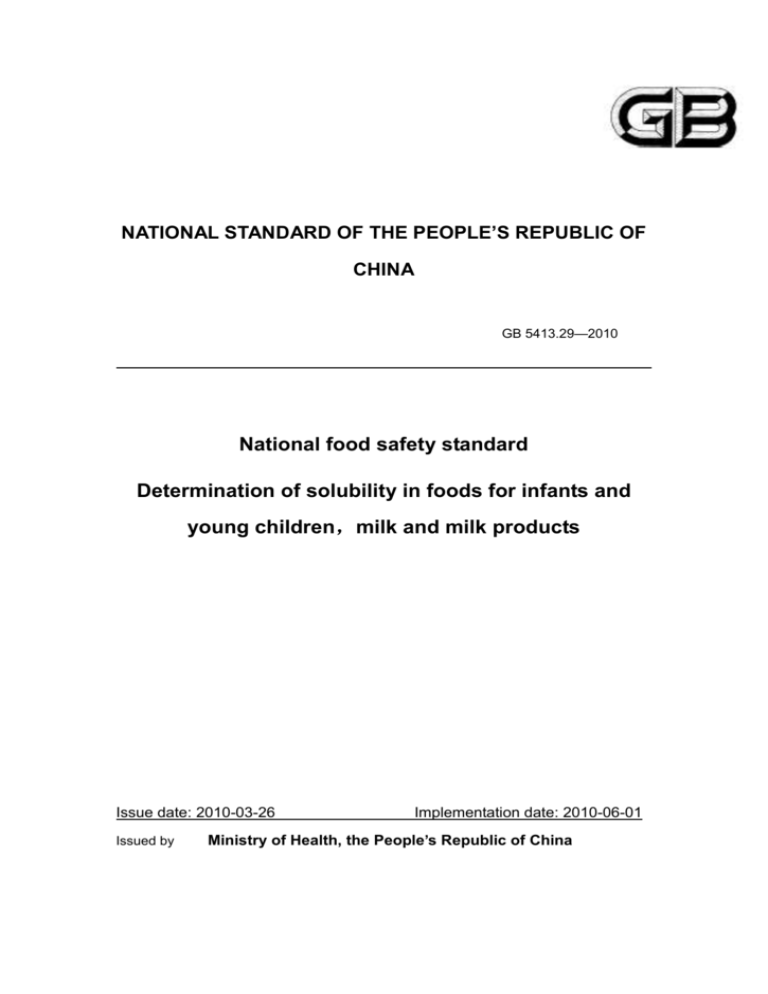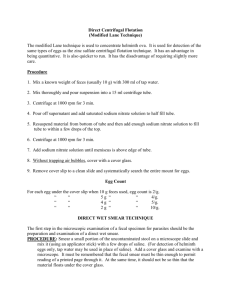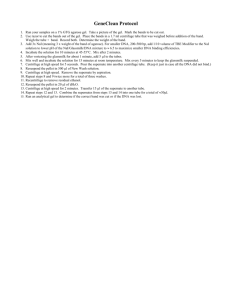
NATIONAL STANDARD OF THE PEOPLE’S REPUBLIC OF
CHINA
GB 5413.29—2010
National food safety standard
Determination of solubility in foods for infants and
young children,milk and milk products
Issue date: 2010-03-26
Issued by
Implementation date: 2010-06-01
Ministry of Health, the People’s Republic of China
Determination of solubility in foods for infants and
young children, raw milk and milk products
Foreword:
Two methods have been given for testing in GB, one is “insolubility index”
determination, which using global standard – IDF129A:1988; the other is
“solubility” method.
GB/T 5413.29-1997 has been replaced by the new standard above.
The standard is provided and all rights reserved by the Health
Administration, PRC.
The old replaced editions are GB 5143-1985, GB/T 5413.29-1997.
1. Range in point
The standard contains two testing methods, which is the “insolubility index”
(Method 1) and “solubility”(Method 2).
Method 1 fits the determination of insolubility index in milk powder with no
soybean.
Determination of solubility in foods and raw milk for infants and young children
is adapted to Method 2.
Method One
The Determination of insolubility index in milk powder
2. Definition
Insolubility index
According to the standard, Regress the milk powder or its related products, then
put into the centrifuge before recording the volume of the sediment.
3. Theory and Methods
To sample, 24 or 50℃ water was added, then technical beater was used to
regress, in still a moment then centrifuged with quite volume regressed milk for
several minutes. The supernatant was abandoned, followed the same
temperature water(24 or 50℃) was added again to mix and solve the sediment
and to have another centrifuge process before noting the bulk of the sediment.
Caution: 24℃ water was used to reconstitute the products in spray drying, and
50℃ water in roller drying.
4. Reagents
All reagents in this work were of analytical grade; Grade 3 water was used in
this experiment.
Silicone defoamer: contains 30% silicone emulsifier.
According to the steps in Chapter 9(No Sample Added) , Less than 0.01mL
silicone residue could be detected from the bottom of centrifuge tube.
5. Instruments
Basically normal instruments
5.1 Water bath with 24±0.2℃or 50±0.2℃, can hold more than one beakers
inside (5.8).
5.2 Thermometer: for testing the temperature in 24℃and 50℃, error ranges
from -0.2℃ to +0.2℃.
Caution: For regressing temperature is one of the vital factors in having effect on
the result of insolubility index, the thermometer used in Chapter 6.1, 6.3 and
6.4.8 should tally with the standard accordingly.
5.3 To weigh sample, spoon was as clean as a whistle, as well as the paper
holding sample (140mm*140mm).
5.4 Balance, the least graduation is 0.01g.
5.5 Plastic graduated flask with 100mL±0.5mL (20℃).
Caution: Compared with the glass flask, specific heat is lower in plastic one, if
add water in it, the temperature changes little.
5.6 Brush, remove the giblets on the spoon or the paper holding the sample (5.3).
5.7 Electric beater, whose characters hereinafter:
a) There are 16 laminas (stainless steel) in beater’s axis, which slopes from right
to left, and the smooth side is gadarene, for the beater with clockwise circling.
Shapes and sizes are given in Pic 1.
b) Angles of 30 degrees between every two laminas. Lamina circle is of 8.73mm
and equal to 11/32 inches. Sizes may be changed for using a period of time, so the
beater should be checked and maintained termly.
c) The cup was held he beater, then the height of the beater’s axis (the distance
between the lamina’s downmost and the bottom of the cup) is of 10mm±2mm,
on the other side, the depth of the cup is 132mm, the distance from the top of the
glass to lamina’s downmost is of 122mm±2mm, two tops between cup and
lamina is 115mm±2mm. Gear is supposed to be in the middle of the cup.
d) To cup, 100mL of 24℃ water added to mix (No matter the sample added) ,
then turn on the power, Lamina’s settled circle rate is of 3600r/min±100r/min in
five seconds. From the picture we can see that the lamina circles clockwise. It’s
more important to check the rev of lamina when in loading termly by using
electric rate detector for old-fashioned beaters. For some non-in-phase
electromotor, the circle rate could be adjusted to 3600r/min±100r/min by the
velometer. (Adapted to some beaters that the circle rate cannot be promised).
1) For some beaters, lamina circles anticlockwise, slopes up from left to right, so
the liquids in the cup caused the flowing effect was the same as the
clockwise-circled beater. In other sides, such as the way to hold the axis and
the distance to the bottom of the cup, the same demand in clockwise and
anticlockwise circling laminas.
5.8 Glass for blending contains 500mL, can use with the beater(5.7)
simultaneously. The Glass (4 laminas), shape and size shown in Pic 1.
5.9 Chronograph: the measure range contains 0-60s and 0-60min.
5.10 Spoon: Length: 210mm.
5.11 Electric centrifuge, which has a screen where rate value can be displayed
and plumb loading. A fitted centrifuge tube and a cover that can turn
outwards are also needed. The acceleration in the bottom of the tube is
160gn. The temperature maintains 20-25 ℃ inside when we cover this
machine.
Caution: In the centrifuge process, the generated accelerate is of 1.12rn2*106;
r - effectively flatly circling radius, mm;
n – circle rate, r/min.
5.12 Glassed centrifuge tube with cone-shaped contains a latex plug. Size,
graduation, label, flecks in non-luster areas have been showed in Pic 2.
Graduation number and the label signed “mL (20℃)” ought to be never
faded as well as the graduation line.
In 20℃, can bear the error in different volumes:
—0.1mL: ±0.05mL;
—0.1-1mL: ±0.1mL;
—1-2mL: ±0.2mL;
—2-5mL: ±0.3mL;
—5-10mL: 0.5mL;
—10mL: ±1mL.
Caution: For daily operating control, using other type tubes are also accepted,
but the volume error must accord with the demands above. If have
some arguments or something should be confirmed, we should use the
tubes prescribed in Chapter 5.1.2.
5.13 Siphon or a pipe connected with the pump, which can remove the liquid
above in the centrifuge tube (5.12). The pipe was manufactured by glass,
containing a upturned U-shaped pipe for siphon (Pic 2).
5.14 Glass rod, Length is 250mm, and 3.5mm for its diameter.
5.15 Magnifier, for reading the bulk value of the sediment.
Picture 1: Mixing and Mixing Impeller
Picture2: Centrifuge Tube and Match Siphon
6. Methods:
6.1 Sample processing:
The sample should be kept in lab with at least 20-25℃and 48 hours, for the
factor effecting the insolubility index going to consistent in every samples before
testing.
Then, Shaking and reversing the container again and again to mix the sample. If
the container is too narrow to mix, we can transfer the sample to a big sanitary,
dry, airtight and un-transparent vessel for mixing fully.
Take care of the instant milk powder when mixing for its granule turn to
diminished.
6.2 Cup for mix round
According to the standard for determination of insolubility index, the pre-mixed
cup would be adjust to 24℃±0.2℃. Another method is to put the cup into water
bath (5.1) for a while until the water level approaches to the top of the cup.
Caution: “24℃±0.2℃ or 50℃±0.2℃ is advisable” is referring to using The
Temperature in paragraph’s below.
6.3 Part of sample
Using the spoon (5.8) or the weighing paper to weigh out (0.01g).
a) To 13.00g for whole milk powder, parts skim powder, sugar-added whole
powder, baby food with milk and other milk powder manufactured by whole
or parts skim milk powder.
b) To 10.00g for skim milk powder and butter milk powder.
c) To 7.00g for whey powder.
6.4 Determination
6.4.1
Take out the cup from water bath, then wipe up the water outside immediately,
and 100mL ± 0.5mL of 24 ℃ ± 0.2 ℃ or 50 ℃ ± 0.2 ℃ water added by the
graduated flask (See Caution 6.2).
6.4.2
3 drops of silicone defoamer (4.1) with sample (6.3) added. Necessarily, brushing
(5.6) the sample fully into the water.
6.4.3
The cup was fasten to the beater (5.7) and turned on the power, after mixing
about 90seconds, then cut off the power. If encountered some non-in-phase
electromotor, the circle rate could be adjusted to 3600r/min±100r/min by the
velometer in the first 5 seconds, then mixed 90 seconds.
6.4.4
Take off the cup from the beater, hold several seconds until the liquid entirely
rushes into the cup from the lamina. Keep it in the room temperature for less
than 5min, no more than 15min
6.4.5
3 drops of silicone defoamer was added into the cup, than using spoon (5.10) to
mix absolutely for 10 seconds (Do not go too far). Then, pouring the mixture into
the centrifuge tube(5.12) with 50mL.
6.4.6
Putting the tubes into the centrifuge symmetrically, and making the machine
started quickly for 5min in 20-25℃. Then, 160gn accelerate was generated in the
bottom of the tubes.
6.4.7
Taking out the tubes, removing the fats above the liquid by somehow spoon.
Holding the tube perpendicularly, liquid above was removed by a siphon or a
pipe(5.13). If it was spray-dried powder, sucking the liquid until overlap with the
generation at 15mL. If it was roller-dried one, 10mL was OK. Do not agitate the
in solution! If the volume of the sediment was over than 15mL or 10mL, just stop
operating, the insolubility index was marked “15mL or >10mL”. Then, signed
the restored temperature as Chapter 7; If not, operating as 6.4.8.
6.4.8
24℃ or 50℃ of water was added into tube up to the generation at 30mL, glass
rod(5.14) was used to churn up the sediment fully. To make the rod approach to
the wall of tube, then added the water at the same temperature to rinse the liquid
on the rod up to the generation at 50mL.
6.4.9
Tube was plugged by a latex stopple, then, overturned five times slowly for
mixing absolutely. Opening the stopple, and ensured the bottom of stopple was
close to the edge of the tube for gathering the inserted liquid. Then, centrifuging
with 5 minutes by stated circle rate and temperature.
Caution: We suggested that the tube’s generation be located in the middle of the
centrifuge when it was in working. Operating in this way, even the top of the
sediment inclined, its volume could be estimated easily.
6.4.10
Take out the tube, then hold it upright, which based on the proper background
for comparison. Make your eyes with the sediment in the same parallel and level,
then reading the bulk value by using magnifying glass(5.15). If the bulk volume
was less than 0.5mL, exacted to 0.05mL; If over 0.5mL, exacted to 0.1mL. If the
sediment on the top inclined, its bulk value could be estimated approximately; If
it was not shipshape on the top, lay down the tube upright for a moment, the
value would be read easily for the sediment being complanate. Remember to note
the water of recovered temperature.
1) The top of the sediment would be clearer and more easily to read when
observed in dark background or lamplight for comparison.
7. Formulation of analysis
Sample insolubility index is referring to the bulk value of the sediment in 6.4.10,
and reporting the temperature of recovered water.
For instance:
0.1mL (24℃)
4.1mL (50℃)
8. Admissible error
8.1 Repeatability
One lab technician tested the same sample twice with the same equipments in a
short time, and the dispersion between two result values would not over 0.138M.
M is the mean value between the two values.
8.2 Reproducibility
Two different lab technicians tested the same sample twice, two result values
should not exceed in 0.328M. M is the mean value between the two values.
8.3Important notice
8.3.1
Go through the experiment continuously, any breaking cannot be accepted when
the testing started. Everyone must obey the law of the temperature and the time
strictly.
8.3.2
We suggested that the determination of insolubility index should be carried out
in a room at 20-25 ℃ for being influenced possibly by the surrounding
temperature.
8.3.3
Lay for 5-15 minutes was promised in the determination process (6.4.4), which
indicated that there was no impact on the insolubility index. A passel of samples
could be tested simultaneously if the cup’s temperature have had been adjusted
(6.2) and the sample were weighed (6.3) aforehand. Thus, modified operating
steps–(6.2)&(6.4.1) were superior to others, namely, to add 100mL±10mL water
to the cup with advisable temperature. As the temperature of the water in the
cup kept steady, then took a cup from the water bath and did the steps by
6.4.1-6.4.4. At the same time, preparing other pre-tested cups in turns to do
centrifuge in batches.
8.3.4 Sample values
The sum content of the solids in water of 100mL (Expressed by the mass number
of the mixture) were approximately equal to the content in original liquids
totally.
8.3.5
It was no need to add 3 drops of silicone defoamer (4.1) to the 6.4.5. But for
consistency, we should do it to all samples.
Method Two
Solubility
9.
Definition
Solubility – The total weight of the sample after solving process in every 100g
sample.
10. Instruments
Basically normal instruments
10.1 Centrifuge tube: 50mL, thick edge, horniness, see Pic 3.
10.2 Beaker: 50mL.
10.3 Centrifuge
10.4 Utensil for weighing: Aluminum or glass made, with 50-70mm diameters.
11 Operating methods:
11.1
5g sample (exacted to 0.01g) was weighted into beaker of 50mL, then 25-30℃ of
38mL water was added to the tube to solve the powder in several trips, to close
with a stopper.
11.2
Take out the centrifuge tube and shake it for 3 minutes after keeping the tube in
the 30℃ water bath for 5 minutes.
11.3
Centrifuging for 10 minutes by proper speed to ensure the insolubility matters
was down. Then remove the supernatant and clean the edge of the tube by cotton
swab.
11.4
To tube, 25-30℃ of 38mL water was added and close with a stopper. Shaking it
uprights for the sediment suspended.
11.5
Repeating the step of 12.3 again.
11.6
To the sediment, a spot of water flushed into the weighted utensil. Put it into the
boiling water bath to evaporate the moisture above, and then moved into the
oven with 100℃ until it turned to constant weight. (The weight discrepancy
could not exceed by 2mg in last twice time)
12. Results of analysis
(m2-m1)*100
Solubility of the sample (g/100g) = 100 - ────────
(1-B)*m
…………… (1)
In formula:
m── the quality of sample, g;
m1── the quality of utensil, g;
m2── the qualities of utensil and insolubility matters after desiccation, g;
B── the moisture of the sample, g/100g.
Caution: Must deduct sugar additively volume when calculation based on
sugar-milk mixed case
13. Admissible error
To the same samples, the discrepancy of values of two tests must not exceed by
2% of their mean value.








